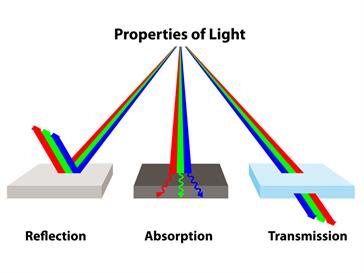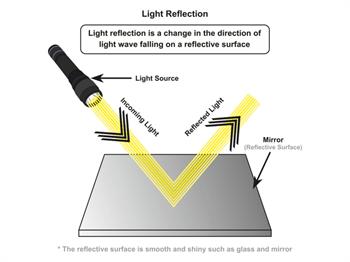PDF chapter test TRY NOW
When a light wave hits an object, many things could happen.
- The object could absorb the light wave; in this case, its energy is converted to heat.
- The object could reflect the light wave.
- And the light wave could be transmitted by the object.

Reflection
Not all objects can create the same effect as produced by the plane mirror. A beam of light, falling on a body with a shiny, polished and smooth surface alone, is bounced back. This bouncing back of the light rays hit the smooth, shiny and polished surface called reflection.

Reflection involves two rays:
- Incident ray and
- Reflected ray
Incident ray:
An incident ray is a ray of light that falling on a surface. The angle between this ray and the perpendicular or normal to the surface is called the incidence angle (angle of incidence).
An incident ray is a ray of light that falling on a surface. The angle between this ray and the perpendicular or normal to the surface is called the incidence angle (angle of incidence).
Reflected ray:
The reflected ray corresponding to a supplied incident ray is the ray that describes the light reflected by the surface. The angle between the surface normal and the reflected ray is called the reflection angle (angle of reflection)
The reflected ray corresponding to a supplied incident ray is the ray that describes the light reflected by the surface. The angle between the surface normal and the reflected ray is called the reflection angle (angle of reflection)
Normal:
At the point of incidence of the light ray, an imaginary line perpendicular to the reflecting surface is called the normal.
The relation between the incident ray, the reflected ray and the normal is given as the laws of reflection.
The laws of reflection are as follows:
- The incident ray, the reflected ray and the normal at the point of incidence, all lie in the same plane.
- The angle of incidence () and the angle of reflection () are always equal.

=
